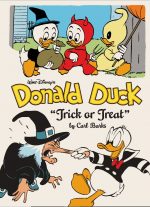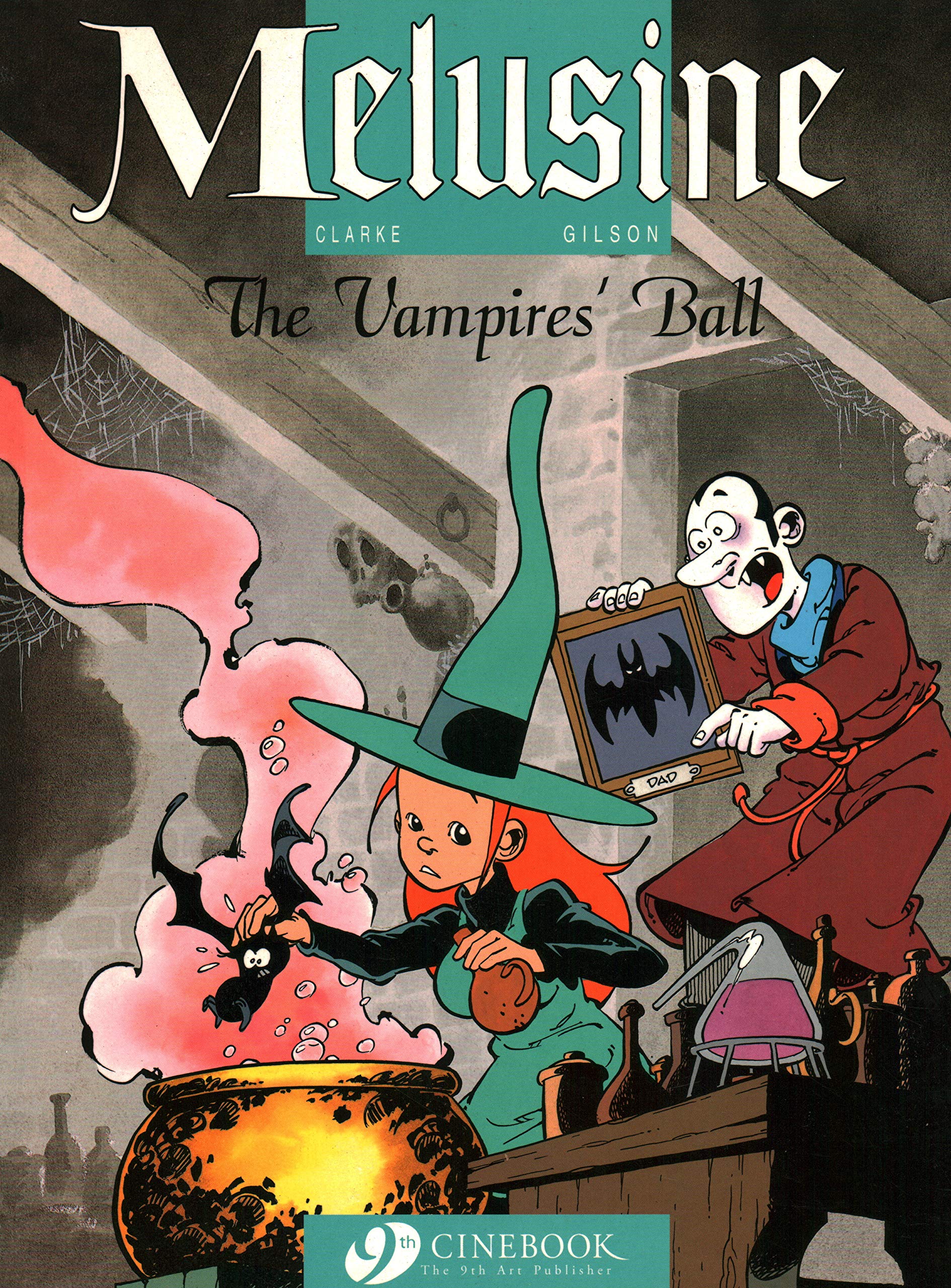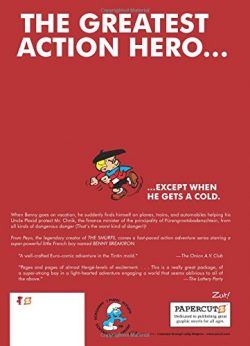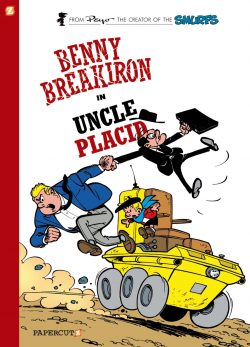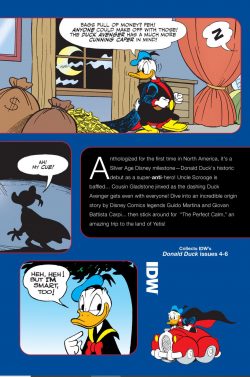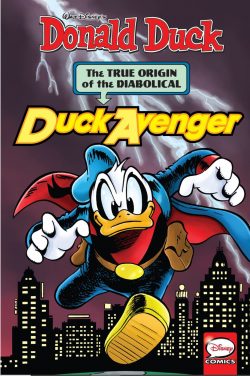
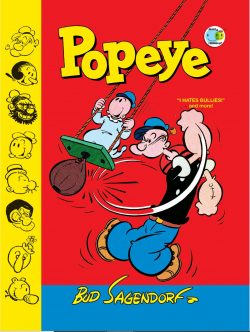
By Bud Sagendorf, edited and designed by Craig Yoe (Yoe Books/IDW Publishing)
ISBN: 978-1-63140-676-8 (HB) eISBN: 978-1-68406-044-3
Win’s Christmas Gift Recommendation: Sweet & Sour Salty Sailor Celebrations… 9/10
How many cartoon classics can you think of still going after a century? Here’s one…
There are a few fictional personages to enter communal world consciousness – and fewer still from comics – but this grizzled, bluff, uneducated, visually impaired old tar with a speech impediment is possibly the most well-known of that august bunch.
Elzie Crisler Segar was born in Chester, Illinois on 8th December 1894. His father was a general handyman, and the boy’s early life was filled with the solid, dependable blue-collar jobs that typified the formative years of his generation of cartoonists. Segar was a decorator, house-painter and also played drums; accompanying vaudeville acts at the local theatre.
When the town got a movie-house, Elzie played silent films, absorbing all the staging, timing and narrative tricks from keen observation of the screen. Those lessons would become his greatest assets as a cartoonist. It was while working as the film projectionist, at age 18, that he decided to become a cartoonist and tell his own stories.
Like so many others in those hard times, he studied art via mail – W.L. Evans’ cartooning correspondence course out of Cleveland, Ohio – before gravitating to Chicago where he was “discovered” by Richard F. Outcault: regarded by most in the know today as the inventor of modern newspaper comic strips with The Yellow Kid and Buster Brown. The celebrated pioneer introduced Segar around at the prestigious Chicago Herald. Still wet behind the ears, the kid’s first strip, Charley Chaplin’s Comedy Capers, debuted on 12th March 1916.
In 1918, Segar married Myrtle Johnson and moved to William Randolph Hearst’s Chicago Evening American to create Looping the Loop, where Managing Editor William Curley foresaw a big future for Segar and promptly packed the newlyweds off to New York: HQ of the mighty King Features Syndicate. Within a year Segar was producing Thimble Theatre, (launching December 19th 1919) in the New York Journal: a smart pastiche of cinema and knock-off of movie-inspired features like Hairbreadth Harry and Midget Movies, with a repertory of stock players acting out comedies, melodramas, comedies, crime-stories, chases and especially comedies for vast daily audiences. It didn’t stay that way for long…
The core cartoon cast included parental pillars Nana & Cole Oyl; their lanky, cranky, highly-strung daughter Olive; diminutive-but-pushy son Castor and the homely ingenue’s plain and (so very) simple occasional boyfriend Horace Hamgravy (latterly, plain Ham Gravy).
Thimble Theatre had already run for a decade when, on January 17th 1929, a brusque, vulgar “sailor man” shambled into the daily ongoing saga of hapless halfwits. Nobody dreamed the giddy heights that stubbornly cantankerous walk-on would reach…
In 1924, Segar created a second daily strip. Surreal domestic comedy The 5:15 starred weedy commuter and would-be inventor John Sappo and his formidable spouse Myrtle. This strip endured – in one form or another – as a topper/footer-feature to accompany the main Sunday page throughout the author’s career, and even survived his untimely death, eventually becoming the trainee-playground of Popeye’s second great humour stylist – Bud Sagendorf.
After Segar’s premature passing in 1938, Doc Winner, Tom Sims, Ralph Stein and Bela Zambouly all took on the strip as the Fleischer Studio’s animated features brought Popeye to the entire world, albeit a slightly variant vision of the old salt of the funny pages. Sadly, none had the eccentric flair and raw inventiveness that had put Thimble Theatre at the forefront of cartoon entertainments. And then, finally, Bud arrived…
Born in 1915, Forrest “Bud” Sagendorf was barely 17 when his sister – who worked in the Santa Monica art store where Segar bought his drawing supplies – introduced the kid to the master cartoonist who became his teacher and employer as well as a father-figure. In 1958, after years on the periphery, Sagendorf finally took over the strip and all the merchandise design, becoming Popeye’s prime originator…
With Sagendorf as main man, his loose, rangy style and breezy scripts brought the strip itself back to the forefront of popularity and made reading it cool and fun all over again. Bud wrote and drew Popeye in every graphic arena for 24 years. When he died in 1994, his successor was controversial “Underground” cartoonist Bobby London.
Bud had been Segar’s assistant and apprentice, and in 1948 became exclusive writer/artist of Popeye’s comic book exploits. That venture launched in February of that year: a regular title published by America’s unassailable king of periodical licensing, Dell Comics.
On his debut, Popeye was a rude, crude brawler: a gambling, cheating, uncivilised ne’er-do-well, but was soon revered as the ultimate working-class hero. Raw and rough-hewn, he was also practical, with an innate, unshakable sense of what’s fair and what’s not: a joker who wanted kids to be themselves – but not necessarily “good”. Above all else he was someone who took no guff from anyone…
Naturally, as his popularity grew, Popeye mellowed somewhat. He was still ready to defend the weak and had absolutely no pretensions or aspirations to rise above his fellows, but the shocking sense of dangerous unpredictability and comedic anarchy he initially provided was sorely missed… except not in Sagendorf’s yarns…
Collected in this superb full-colour hardback/digital edition are Popeye #35-39, crafted by irrepressible “Bud”: collectively spanning January-March 1956 to January-March 1957.
Stunning, nigh stream-of-consciousness slapstick sagas are preceded by an effusively appreciative ‘Society of Sagendorks’ briefing by inspired aficionado, historian and publisher Craig Yoe, offering a mirthful mission statement, and enhanced by another tantalising display of ephemera and merchandise in ‘A Bud Sagendorf Scrapbook’. This time we focus on the 1980 Robert Altman movie with candid cast photos, Sagendorf illustrated tie-in magazine articles, and multi-lingual cartoon iterations.
We rejoin the ceaseless parade of laughs, surreal imagination and thrills with quarterly comic book #35, opening with a monochrome inside front cover gag concerning the latest hobby of the sailor’s ward after which ‘Thimble Theatre presents Popeye and Swee’Pea in “Wishing” or Spinach is Still King!”’, wherein the bored “infink” shambles upon an alien incursion and tricks the haughty invaders out of their irresistible, unbeatable Wish-o-Matic machine…
Soon the impressionable kid is king of the world and Popeye is forced into drastic action…
The family is afloat for follow-up bedtime tale ‘I Hates Bullies!’ as the mariner, Olive and Wimpy are lured to an exotic island and seduced into liberating its people from enslaving Boss Black Allen…
Back-up feature Sappo was by now reduced to gullible foil and hapless landlord to the world’s worst lodger. Professor O.G. Wotasnozzle – The Professor with the Atomic Brain would callously inflict the brunt of his genius on the poor schmuck. Here that means inventing super-fast growing redwoods but being too self-absorbed to keep the seeds out of the rain…
The issue ends with an endpaper prose fable about a scientist who regretted getting cats to chase his lab mice and a back cover gag of bath night for Swee’Pea…
Issue #36 (April-June) began with ‘King Popeye of Popilania!’ as the sailor man sets out to create the perfect country, but soon finds kinging it is a lot of work, especially if your friends are all ambitious traitors and other nations think they can push you around…
For a while things look bleak for the Popilania, until the desperate King unleashes secret weapon General Wimpy…
An engaging Micawber-like coward, cad and conman, the insatiably ravenous J. Wellington Wimpy debuted in the newspaper strip on May 3rd 1931 as an unnamed, decidedly partisan referee in one of Popeye’s pugilistic bouts. Scurrilous, aggressively humble and scrupulously polite, the devious oaf struck a chord and Segar made him a fixture. Preternaturally hungry, ever-keen to solicit bribes and a cunning coiner of many immortal catchphrases – such as “I would gladly pay you Tuesday for a hamburger today” and “Let’s you and him fight” – Wimpy was the perfect foil for our straight-shooting action hero and increasingly stole the entire show… and anything else unless it was very heavy or extremely well nailed down. He proved to be the ultimate deterrent in an extended war that depended on keeping troops fed…
Popeye an’ Swee’Pea then turn the tables on villainous reprobate Poopdeck Pappy after the sailor’s crooked father fakes his own death in ‘Pappy’s Spook’, before Professor O.G. Wotasnozzle – The Atomic Brain! conjures fresh chaos with his terrifying reducing pills in advance of another text tale. ‘Canned Nuts’ details the downfall of a prudent squirrel who had a plan (but no tin-opener) in advance of a back cover gag of Popeye and Wimpy fishing…
Cover-dated July-September, Popeye #37 opens with a monochrome inside cover about Swee’Pea’s garden before main event ‘The Search for the Spinach Icebox’ sees our well-travelled hero targeted by secret society WAFPOM (World Association For Prevention Of Muscles) after he buys two million tons of the miraculous mineral rich vegetable. With attacks mounting, he needs someplace safe to store his leafy treasure and on Wimpy’s suggestion heads to Antarctica, where WAFPOM and even stranger foes are waiting…
‘Amateur Inventor!’ Sappo gives O.G. Wotasnozzle a taste of his own medicine next, before ‘The Big Sting’ heralds the end of another issue with the prose history of a bullying bee…
Issue #38 opens with a monochrome pet gag and an extended colour epic as Popeye and The Gang meet ‘The Dog Who Wore A Crown” – or – Going To the Dogs!’ A quick visit with King Blozo finds the scatty ruler absent and his dog ruling in his stead. Most annoyingly, the monarch has appointed Popeye Royal Dog Sitter. As the dutiful sailor surrenders to the inevitable, things get more complicated when the moody pooch – AKA “Birdseed” – decides Swee’Pea should be in charge…
‘Bottle Fish!’ sees the text fixture shift to the comic’s centre with the tale of a mean bully stuck behind glass, after which Wotasnozzle and Sappo both go overboard in a fishing contest augmented by weird science and the chaos concludes with another black-&-white inner cover pet prank, preceding a new year of fun and frolic as #39 (January-March 1957) feature more monochrome madness for Swee’Pea’s pooch…
The gang are rattled in lead story ‘The Mountain that Talked Back!’ as Olive’s deteriorating nerves prompt a vacation on ominously named “Thunder Island” and a badly-timed stay on a volcano in full eruption mode…
Everything changes once Popeye realise the shakes are fakes and a gang of criminals are making them patsies in a plot and our hero breaks out the spinach…
Prose parable ‘Cow?’ reveals how bovine Mildred briefly lived her dream to be a horse, after which Wotasnozzle seeks to improve communication by reinventing words in ‘What Did He Say?’ before Swee’Pea and Birdseed monopolise interior monochrome and exterior color gags with devasting effect.
Outrageous and side-splitting, these universally-appealing yarns are evergreen examples of narrative cartooning at its most surreal and inspirational. Over the last nine decades Thimble Theatre’s most successful son has delighted readers and viewers around the world. This book is simply one of many, but each is sure-fire, top-tier entertainment for all those who love lunacy, laughter, frantic fantasy and rollicking adventure. If that’s you, add this compendium of wonder to your collection.
Popeye Classics volume 8 © 2016 Gussoni-Yoe Studio, Inc. All Rights Reserved. Popeye © 2016 King Features Syndicate. ™ Heart Holdings Inc.




